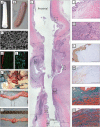Recent advances in ureteral tissue engineering
- PMID: 25404179
- PMCID: PMC4234891
- DOI: 10.1007/s11934-014-0465-7
Recent advances in ureteral tissue engineering
Abstract
Reconstruction of long ureteral defects often warrants the use of graft tissue and extensive surgical procedures to maintain the safe transport of urine from the kidneys to the urinary bladder. Complication risks, graft failure-related morbidity, and the lack of suitable tissue are major concerns. Tissue engineering might offer an alternative treatment approach in these cases, but ureteral tissue engineering is still an underreported topic in current literature. In this review, the most recent published data regarding ureteral tissue engineering are presented and evaluated, with a focus on cell sources, implantation strategies, and (bio)materials.
Conflict of interest statement
Paul K.J.D. de Jonge, Vasileios Simaioforidis, Dr. Paul J. Geutjes, Dr. Egbert Oosterwijk, and Dr. Wout F.J. Feitz each declare no potential conflicts of interest.
Figures

References
-
- Dowling RA, Corriere JN, Jr, Sandler CM. Iatrogenic ureteral injury. J Urol. 1986;135(5):912–915. - PubMed
Publication types
MeSH terms
LinkOut - more resources
Full Text Sources
Other Literature Sources
Medical

